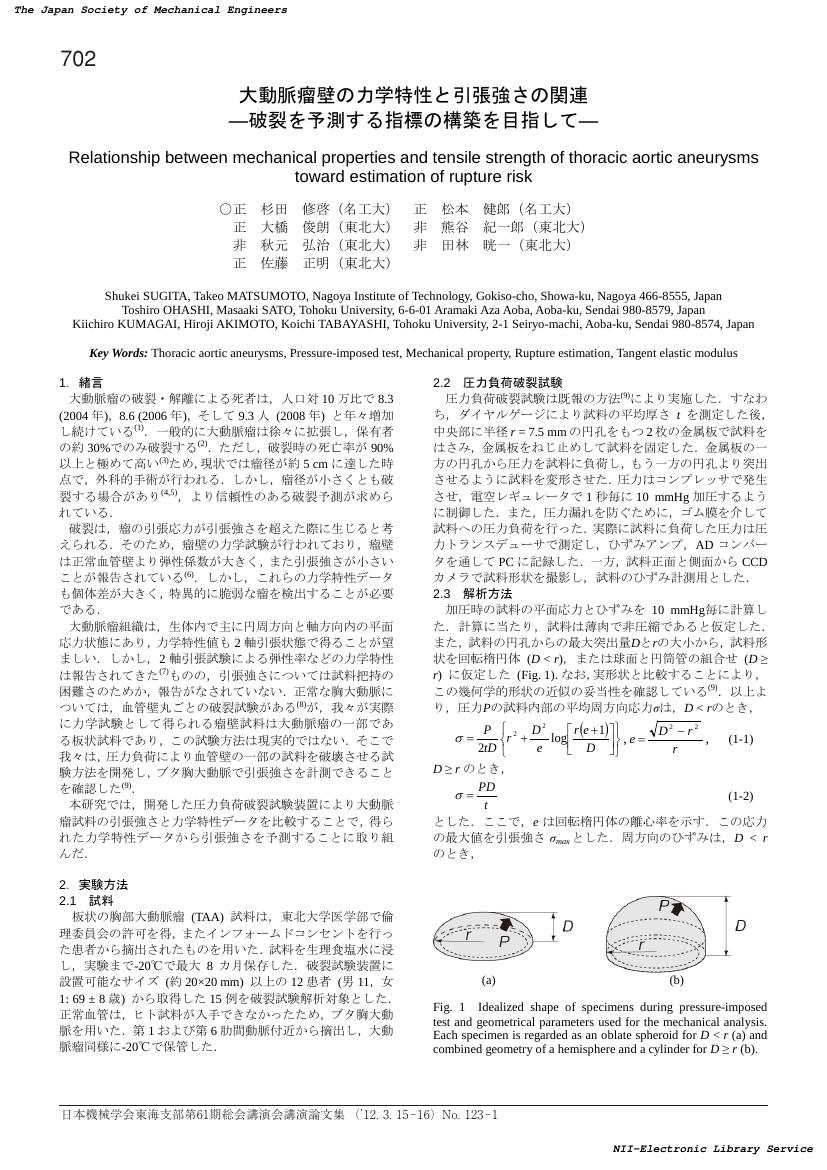2 0 0 0 ブラジャー着用による胸部振動の抑制
- 著者
- 村瀬 晃平 ZHU JING 松本 健郎
- 出版者
- 一般社団法人 日本機械学会
- 雑誌
- バイオエンジニアリング講演会講演論文集 2017.29 (ISSN:24242829)
- 巻号頁・発行日
- pp.2D17, 2017 (Released:2017-06-19)
2 0 0 0 OA オシロメトリック法を用いた上腕動脈内圧-断面積関係の非侵襲計測:装置の開発と検証
- 著者
- 松本 健郎 梅田 宗紀 西林 秀郎 石塚 繁廣 高橋 慎一
- 出版者
- 公益社団法人 日本生体医工学会
- 雑誌
- 生体医工学 (ISSN:1347443X)
- 巻号頁・発行日
- vol.51, no.4, pp.261-267, 2013-08-10 (Released:2013-12-11)
- 参考文献数
- 12
A novel apparatus for noninvasive measurement of pressure-cross-sectional area relationship, i. e., tube law, of brachial artery was developed. It is based on an oscillometric method in which a cuff is wrapped around the upper arm and pressurized to measure the oscillation in the cuff pressure. The oscillation of the cuff pressure is caused by the volume change in the brachial artery due to heartbeats. The volume change was obtained by multiplying the amplitude of the cuff pressure with cuff compliance that had been measured from the increase in the cuff pressure just after loading a precise amount of air into the cuff. Oscillation of the cuff pressure disappears when the artery is collapsed. By using this principle, an occluding pressure OP when the artery begins to collapse was measured. A modified transmural pressure mPt was introduced whose origin was taken at the point where the external pressure of the artery, i. e., the cuff pressure equals to OP. Relationship between mPt and cross-sectional area of the artery A was obtained as the tube law:The volumetric change of the brachial artery was obtained at each mPt and was fitted to the function $\displaystyle A=A_b \left\{ \frac{1}{b} \ln \left( \frac{ {}_mP_t - P_b } {a} +1 \right) +1 \right\}$ where Ab, Pb, a, and b are constants while assuming constant pulse pressure. Volume elastic modulus VE and in vivo cross-sectional area eA of the brachial artery were obtained from the tube law. Estimated tube law was very similar to that obtained by measuring the diameter of the brachial artery with ultrasound while changing the transmural pressure by pressurizing and depressurizing an airtight chamber that had been attached around the upper arm. Estimated eA correlated well with eA measured by ultrasound (R2=0.930, PVE obtained in the two methods was less than±3% (n=5). The present method is capable of obtaining pressure-cross sectional relationship of the brachial artery correctly with a simple process comparable to blood pressure measurement. Since it has been reported that in vivo brachial artery diameter correlates well with the severity of atherosclerosis, eA obtained in the present method might become a promising index for atherosclerosis.
1 0 0 0 OA 細胞のバイオメカニクス:組織再生に向けたメカノトランスダクションの理解とその制御
- 著者
- 長山 和亮 松本 健郎
- 出版者
- 一般社団法人 日本人工臓器学会
- 雑誌
- 人工臓器 (ISSN:03000818)
- 巻号頁・発行日
- vol.42, no.3, pp.205-208, 2013-12-15 (Released:2014-03-21)
- 参考文献数
- 27
- 著者
- 森 麻子 生田 直子 長山 和亮 天野 聡 松本 健郎
- 出版者
- 一般社団法人 日本機械学会
- 雑誌
- バイオフロンティア講演会講演論文集
- 巻号頁・発行日
- vol.2006, pp.97-98, 2006
- 著者
- 杉田 修啓 松本 健郎 大橋 俊朗 熊谷 紀一郎 秋元 弘治 田林 晄一 佐藤 正明
- 出版者
- 一般社団法人 日本機械学会
- 雑誌
- 東海支部総会講演会講演論文集 2012.61 (ISSN:24242748)
- 巻号頁・発行日
- pp._702-1_-_702-2_, 2012-03-15 (Released:2017-06-19)
1 0 0 0 生物の3D形態を構築するロジック
- 著者
- 近藤 滋 芳賀 永 秋山 正和 松本 健郎 上野 直人 松野 健治 武田 洋幸 井上 康博 大澤 志津江
- 出版者
- 大阪大学
- 雑誌
- 新学術領域研究(研究領域提案型)
- 巻号頁・発行日
- 2015-06-29
28年度の総括班では、既に、班としてのシステムの構築がほぼ終わっているために、既存の共有装置の維持管理が主なものになる。2機の3Dプリンターは、全班員の研究に有効に使用されている。28年度に、総括班費で購入した機器は、顕微鏡用の共焦点レーザーユニット(北海道大学:999万円)と、ズーム顕微鏡(基礎生物学研究所:299万円、原子間力顕微鏡の一部として購入)である。いずれも、他の資金で購入したパーツと組み合わせることで、購入金額の節約をしている。両装置とも、3D形態の計測に必須であり、共同利用が進んでいる。班会議は北大で、5月23,24日に行った。理論系と実験系の交流を目的とする夏、冬の合宿は、9月4,5,6日と、3月28、29日に、淡路島、琵琶湖で行った。いずれも、学生の旅費の補助を総括班費から支出している。これまで、合宿は主に比較的少人数で行ってきたが、2016年度は、公募班員からの希望が多かったために、冬の合宿では会場を変えた。非常に活発な議論が行われたが、参加者が多くなりすぎたため、プロジェクトごとの議論の時間が逆に短くなり、やや、食いたりない面もあった。この点の解消が、今後の課題として残された。北海道大学の秋山は、定期的に、数学と3Dソフトの講習会を行っており、そのための実費(交通費、宿泊費)の支援を行った。その他、HPの更新に約30万円を支出している。
1 0 0 0 3D形態ロジックの国際共同研究を加速するバーチャル研究所
- 著者
- 近藤 滋 武田 洋幸 上野 直人 松野 健治 松本 健郎 芳賀 永 井上 康博 秋山 正和 大澤 志津江
- 出版者
- 大阪大学
- 雑誌
- 新学術領域研究(研究領域提案型)
- 巻号頁・発行日
- 2015-11-06
主な活動は以下の4点である。1:7月10,11日にアメリカ合衆国カリフォルニア大学アーバイン校と合同で、3D形態形成に関するシンポジウムを開催し、同時に、今後の技術協力体制の拡大に関して話し合いを行った。アメリカ側の主催者であるKen Cho博士は分子発生学の世界的な権威であり、今後も、交流を続けることを確認した。2018年の本研究班の班会議にKen cho博士を招き特別講演をお願いすることが決まっている。また、上野研究室との共同研究も現在進行中である。2:河西通博士をHarvard Medical School のSean Megason研究室へ派遣し、ゼブラフィッシュ胚における組織の3次元構造の発生機構の研究を共同研究で行っている。これは前年度からの継続である。昨年度より、細胞レベルでの挙動を定量的に解析しており、特に、In toto imagingなどの観測技術を武田研究室に移植している。河西通博士の派遣は、2018年度で終了する予定。3:近藤班の3名が、前年に引き続き、コスタリカでツノゼミサンプルの採取を行った。今年度は、プロジェクトの目的がはっきりしており、特にヨツコブツノゼミの幼虫、ヨコツノツノゼミの幼虫、の2種に絞り、採集を行った。結果として、それぞれ70匹、200匹のサンプル採集に成功し、エタノール固定ののち、コスタリカ大学ポールハンソン教授の仲介で、日本に送付していただいている。今後の近藤班の研究は、このサンプルの解析が中心となる。4:近藤研究室の学生、松田佳祐を3D形態の計算で世界的に有名なプルシェミック研究室に約2か月滞在させ、原基の折り畳みソフトの高速化技術を学び、昨年作った展開ソフトを改良した。


